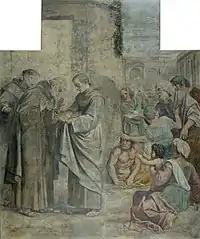| Mural Paintings from the Herrera Chapel | |
|---|---|
 | |
| Artist | Annibale Carracci |
| Year | 1604–1606 |
| Type | Fresco transferred to canvas |
| Location | Museu Nacional d'Art de Catalunya & Museo del Prado, Barcelona & Madrid |
The Mural Paintings from the Herrera Chapel is a group of mural paintings by Annibale Carracci and collaborators, of around 1602, now divided between the National Art Museum of Catalonia in Barcelona,[1] and the Museo del Prado in Madrid.
They are frescos that were painted for a chapel in Rome around 1604, but later transferred to canvas and moved to Spain by 1851.
History
In 1602, the Spanish nobleman Juan Enriquez de Herrera dedicated a chapel to the Spanish Franciscan Saint (Didacus or) Diego de Alcala in what is now Nostra Signora del Sacro Cuore in Rome, but was then "Saint James of the Spanish", the Spanish national church in Rome. He commissioned Saint Didacus of Alcalá Presenting Juan de Herrera's Son to Christ and frescoes from Carracci. The mural decoration, with scenes from the saint's life, was done by the Bolognese painter Annibale Carracci. In 1604 began designing the master of all the preparatory cartoons, but he became ill while personally directing the work 'in situ'. So, the work was finished by his collaborators, who included Giovanni Lanfranco, Sisto Badalocchio and Francesco Albani.
The Spanish national church in Rome later became the new Santa Maria in Monserrato degli Spagnoli, and the old church was cleared of its artworks. The frescoes in the Herrera chapel were transferred to canvas at the request of the sculptor Antonio Solá, at the expense of Ferdinand VII (d. 1833), and arrived in Spain in 1851. They are now distributed between MNAC and Museo del Prado.
Description
The group consists of 16 items, 9 of which are kept at the MNAC[2] and the other 7 at the Museo del Prado in Madrid. From the former church of San Giacomo degli Spagnuoli in Rome.[3]
| # | Image | Title | Authors | Museum | Reference |
|---|---|---|---|---|---|
| 1 |  | Apostles around the Empty Sepulchre | Carracci and Francesco Albani | MNAC | [4] |
| 2 |  | Miracle of the Roses | Carracci, Francesco Albani and Domenico Zampieri | MNAC | [5] |
| 3 |  | Assumption of the Virgin | Carracci and Albani | MNAC | [6] |
| 4 |  | Everlasting Father | Carracci and Albani | MNAC | [7] |
| 5 |  | Healing the Man Born Blind | Carracci and Albani | MNAC | [8] |
| 6 |  | Saint Paul | Carracci and Albani | MNAC | [9] |
| 7 |  | Saint Peter | Carracci and Albani | MNAC | [10] |
| 8 |  | Predicació de Sant Dídac | Carracci and Sisto Badalocchio | MNAC | [11] |
| 9 |  | Apparition of Saint Didacus above his sepulchre- | Carraci and Sisto Badalocchio | MNAC | [12] |
| 10 |  | Apoteosis de san Francisco | Museo del Prado | [13] | |
| 11 |  | Apoteosis de Santiago el mayor | Museo del Prado | [14] | |
| 12 |  | Apoteosis de san Lorenzo | Museo del Prado | [15] | |
| 13-17 | Escenas de San Diego de Alcalá, titular de la capilla | Museo del Prado | [16] |
References
- ↑ Guide of the Museu Nacional d'Art de Catalunya. MNAC, 2004. ISBN 84-8043-136-9
- ↑ The artwork at MNAC's Website
- ↑ Museo del Prado
- ↑ Apòstols al voltant del Sepulcre buit
- ↑ Miracle de les roses al web del MNAC
- ↑ Obra al web del MNAC
- ↑ Obra al web del MNAC
- ↑ Obra al web del MNAC
- ↑ Obra al web del MNAC
- ↑ Obra al web del MNAC
- ↑ Obra al web del MNAC
- ↑ Obra al web del MNAC
- ↑ Museo del Prado P-76
- ↑ Museo del Prado P-77
- ↑ Museo del Prado P-78
- ↑ Museo del Prado P-79, P-2908, P2909 and P-2910
